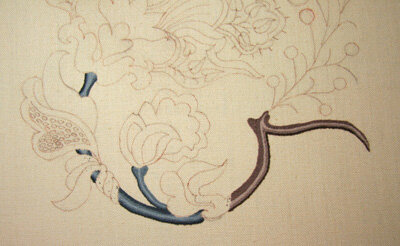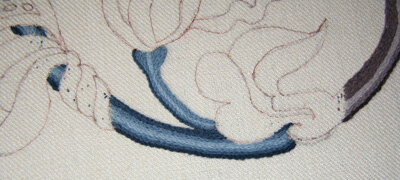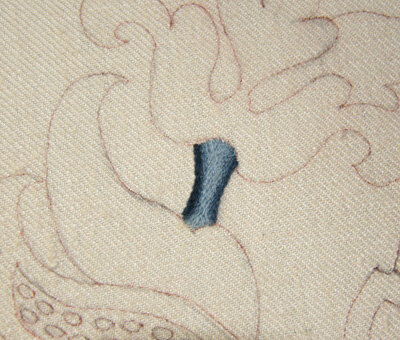This is a BIG stem!
Stem stitch, more stem stitch and even MORE stem stitch. It seemed endless as I was plugging away at the BIG stem on the Royal Persian Blossom design. Part of the endlessness of it was because this is a big design. Part of the reason it felt like I was stitching forever was because I was using Heathway wool, which is a finer wool than Appleton wool so I needed to work more rows of stem stitch to fill the space. A lot more rows! The wool is just lovely - soft, smooth and stitches beautifully, so I don't mind doing more rows. Fine and delicate is better than coarse and fuzzy in my book. For this design, this is the perfect wool for me. What I should have done (and I don't "should of" myself very often - life's too short!) was to do a test on a scrap of fabric so I would know how many rows filled up say, 1 cm of width. That would have been clever. Note to self - do it next time, silly woman!Because I didn't know how many rows of stem stitch would fill up 1 cm of width (or 2 cm or 7 cm for that matter!) I misjudged and the shading on the gray/brown part of the stem isn't as nice as the shading on the blue part of the stem. I could go back and fix it and I might, but not now. It looks OK and I'm not unhappy with it.When it was time to begin the blue section, I had a much better handle on how the thread stitched up so I was more confident on how many rows of each shade of blue to do before changing to the next shade. You can see that the shading is much better. The shading is done by alternating dark to lighter shades on alternate sides of the stem. Here's what I mean: using 7 shades of blue wool, with 7 being the darkest and 1 the lightest shade, the stem was stitched from one side to the other in this order 7, 5, 3, 1, 2, 4, 6. This puts the darkest shade on the outside and the lightest in the middle but doesn't make both sides exactly identical. It is a brilliant technique and something new for me that I've learned from this project.
What I should have done (and I don't "should of" myself very often - life's too short!) was to do a test on a scrap of fabric so I would know how many rows filled up say, 1 cm of width. That would have been clever. Note to self - do it next time, silly woman!Because I didn't know how many rows of stem stitch would fill up 1 cm of width (or 2 cm or 7 cm for that matter!) I misjudged and the shading on the gray/brown part of the stem isn't as nice as the shading on the blue part of the stem. I could go back and fix it and I might, but not now. It looks OK and I'm not unhappy with it.When it was time to begin the blue section, I had a much better handle on how the thread stitched up so I was more confident on how many rows of each shade of blue to do before changing to the next shade. You can see that the shading is much better. The shading is done by alternating dark to lighter shades on alternate sides of the stem. Here's what I mean: using 7 shades of blue wool, with 7 being the darkest and 1 the lightest shade, the stem was stitched from one side to the other in this order 7, 5, 3, 1, 2, 4, 6. This puts the darkest shade on the outside and the lightest in the middle but doesn't make both sides exactly identical. It is a brilliant technique and something new for me that I've learned from this project. One of the things I love about this design is how the stem comes peeking through the other elements. When only the stem has been finished, it's easy to see how the design elements work together.Remember the rule about stitching the elements in the back of the design first? It's clear that the stem is in the background of this design when you see it with only the stem finished.
One of the things I love about this design is how the stem comes peeking through the other elements. When only the stem has been finished, it's easy to see how the design elements work together.Remember the rule about stitching the elements in the back of the design first? It's clear that the stem is in the background of this design when you see it with only the stem finished. Thus far I've loved working on this project. It's so beautiful that every time I stand up from my frame and look at it, I'm excited to get back to work and get more done!
Thus far I've loved working on this project. It's so beautiful that every time I stand up from my frame and look at it, I'm excited to get back to work and get more done!